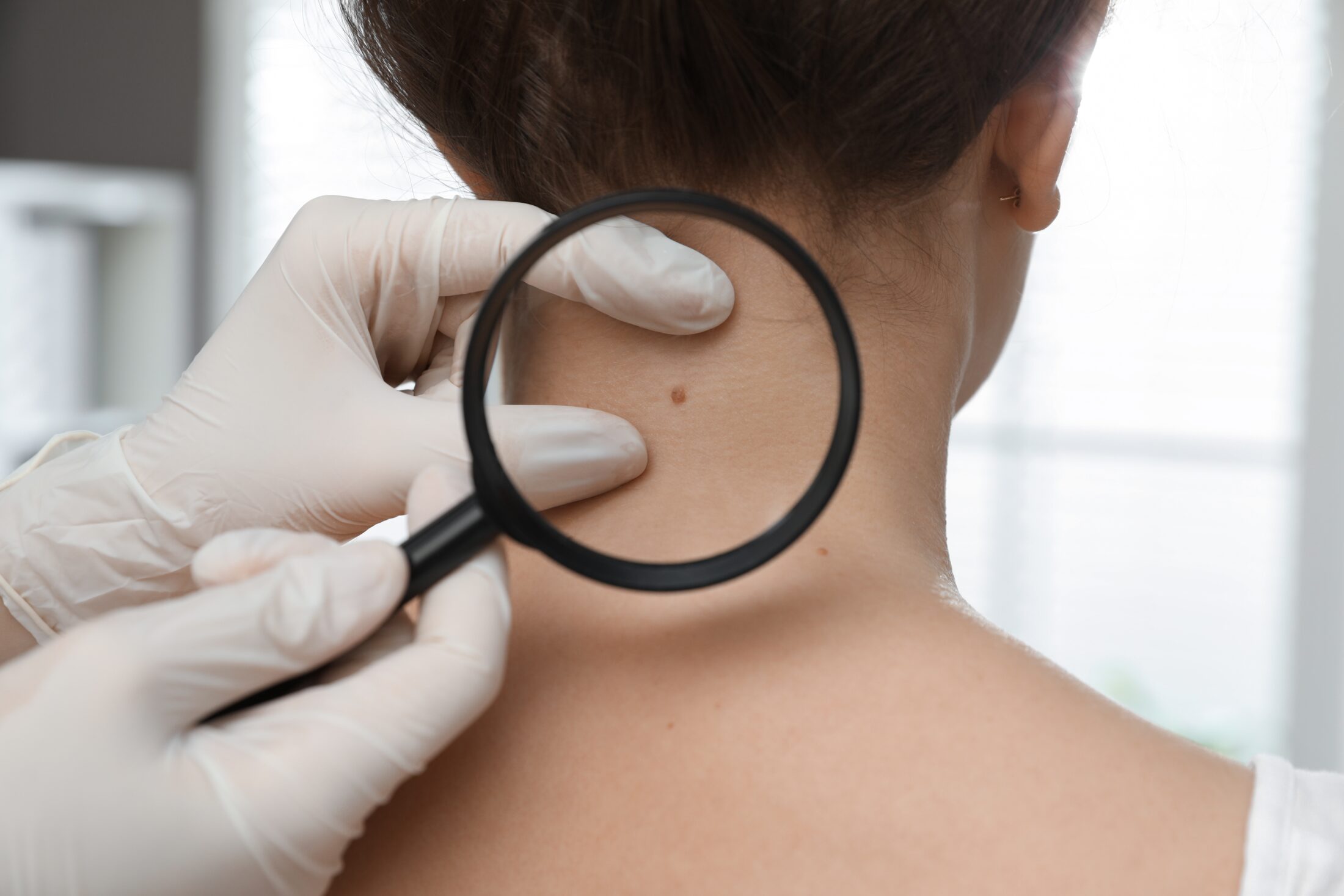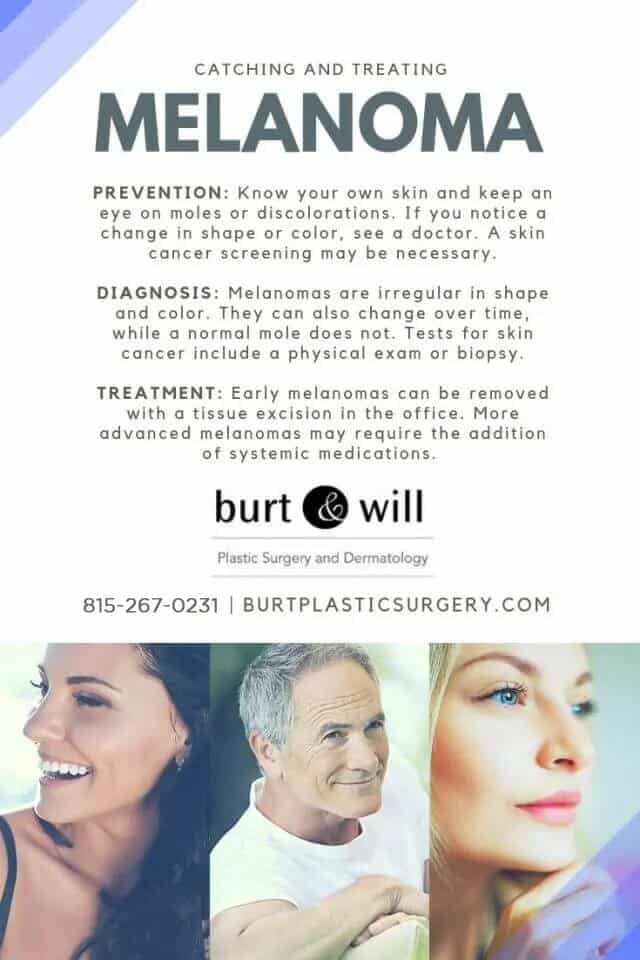
Skin Cancer Screening and Treatment
The most common form of cancer in America is skin cancer – with the number of cases climbing each year. It is estimated that one in five Americans will develop skin cancer, and it affects people of all ethnicities – not just the fair complected. Outdoor activities like boating, sunbathing, or working in the sun, as well as indoor tanning, make people more susceptible to developing skin cancers.
It’s critical to differentiate a normal dark spot and other lesions from a deadly melanoma. We offer comprehensive skin evaluations of growths and moles, utilizing dermoscopy (a polarized light tool) to identify skin cancers early and biopsy lesions that have atypical features. We treat skin cancers using multiple approaches, educate you on your options, and recommend what is most appropriate for this type of cancer and your health.
Benign (non-cancerous) Growths
With wisdom and age may come new skin growths and brown spots; fortunately, many are completely harmless. Sunspots (lentigines) can occur over the chest and arms, and raised brown overgrowths of the top layer of the skin (seborrheic keratosis) are common on the trunk after the age of 30. Skin tags regularly occur in the armpits and skin folds, overactive oil glands often appear on the face (sebaceous hyperplasia), and cysts can grow on different parts of the body. The key is first properly identifying these as harmless; then, if desired, cosmetic treatments can be applied to minimize their appearance.

Before & After Photos
Explore our before and after gallery to witness the remarkable transformations that have left our clients feeling more confident and beautiful than ever. From subtle enhancements to dramatic makeovers, our gallery showcases the artistry of transformation.
Treatment for Benign Growths
Benign growths can be treated in a variety of different ways – it all depends on the type of growth and the patient’s ultimate goals. Sunspots, areas of discoloration, and similar cosmetic concerns are commonly treated using laser resurfacing, chemical peels, cryotherapy, and lightening creams. Skin tags and warts are often removed with cryotherapy, excision and occasionally laser treatments as well.
Moles and Melanoma
While moles (brown or pink pigmented spots on the skin) are common, it’s important to differentiate them from melanoma – an aggressive type of skin cancer. Typically, moles will develop in our childhood years before the age of 20, and all our moles should share a relatively similar color, size, and shape. If there is an ugly duckling mole (one that looks different than other moles), or changes are occurring in a mole, it should be promptly evaluated.
A commonly used method to help identify melanomas is following the ABCDE guide:
- Asymmetry of shape – the left and right side of a mole should look similar
- Border irregularities – notched, scalloped or poorly defined borders are concerning
- Color variation – multiple shades or colors within one mole are suspicious
- Diameter – usually melanomas are larger than 6mm, but they can be smaller
- Evolving – melanomas tend to gradually change with time
Early diagnosis and treatment of melanomas can make the condition nearly 100% curable, but even with a later diagnosis, we work closely with other specialists to develop the most up-to-date treatment regimen for your melanoma – and we’ll follow you every step of the way.
Treatment for Moles and Melanoma
Moles that are not cancerous can be monitored in clinic by our physicians to ensure they do not develop any atypical features. These can easily be removed for cosmetic purposes as well. Atypical moles are biopsied to ensure there is no skin cancer. This is done in one of a couple ways, depending upon the location, size, and type of atypical features noted – either cut out and carefully stitched, or strategically cut out using a “shave” technique. In both situations, the doctor numbs the area with local anesthesia to make the patient comfortable during the procedure.
Melanoma treatments vary depending upon the stage of the skin cancer at time of diagnosis. In cases when the melanoma is in an early, “thin,” stage, the melanoma can be surgically excised with a straight forward procedure in the office. For deeper melanomas, additional evaluation of the local lymph nodes, called a sentinel lymph node biopsy, may be considered. If the melanoma has spread to the lymph nodes or elsewhere, systemic medications (including immunotherapy or chemotherapy) can be used.

Actinic Keratosis
Actinic keratoses are precancerous lesions, often occurring on the face, scalp, and arms. With a rough, red appearance, these growths occur after years of sun exposure and have the potential to turn into skin cancer.
Treatment for Actinic Keratosis
We employ a range of modalities to treat these lesions and prevent them from progressing. Some of the most common treatments include cryotherapy and a variety of topical products.
Basal Cell Carcinoma
Basal cell carcinoma, the most common type of skin cancer, usually presents as a red, smooth bump. Often on the face, these growths can bleed and locally invade the skin, though they uncommonly spread to other parts of the body. Early detection is key, and after identifying these skin cancers, we will educate you on all the options available and let your preferences steer your treatment plan.
Treatment for Basal Cell Carcinoma
Treatments may involve the application of a topical cream, surgically removing the skin cancer, a Mohs procedure, electrodessication and curettage (ED&C), or oral medications.
Squamous Cell Carcinoma
Similar to basal cell skin cancers, squamous cell carcinomas show up as red spots, but these are often rough and scaly. The product of many years of sun damage, these cancers tend to destroy the tissue around them and, when neglected, can spread to other areas in the body. Early detection is vital to identifying and treating this type of skin cancer, and multiple treatment modalities are available.
Treatment for Squamous Cell Carcinoma
Treatment for squamous cell carcinoma varies depending on the size and type of the lesion, and its location on the body. Common treatments include topical creams, excisional surgery, electrodessication and curettage (ED&C), and Mohs surgery.
Schedule a Consultation! Serving the Morris, Burr Ridge, and Plainfield Areas
Our skin care professionals are trained to catch the early signs of pre-cancers, malignant melanoma, squamous cell cancers, and basal cell cancers. The best way to detect possible skin health concerns as early as possible is with regular skin cancer screenings at Burt and Will Plastic Surgery and Dermatology.
We offer skin cancer screenings and use specialized dermatoscope tool to increase our ability to detect skin cancers. Early detection of skin cancer through a full face and body examination is the best way to catch symptoms, and we teach you what to look for as well. When treated early, most forms of skin cancer are fully curable.
If you would like to learn more about skin cancer screening and skin cancer treatments, please contact us. We serve the Chicagoland area, with locations in Morris, Burr Ridge, and Plainfield.
